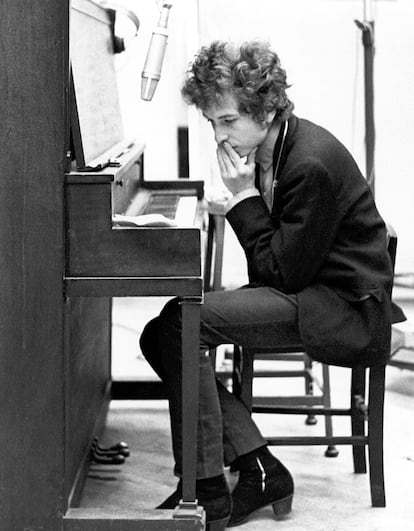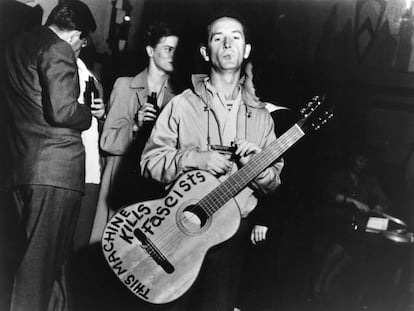Bob Dylan in Japan: portrait of a curiously happy bard
His much-maligned live album recorded at Budokan in Tokyo makes a comeback after 45 years with previously unreleased tracks

Dylanism is a mysterious and expensive religion that offers compelling arguments for believing in salvation. The latest item coveted by Bob Dylan’s faithful is a four-CD box set of two complete concerts, originally released in late 1978 as the live double album Bob Dylan at Budokan. It features all 22 songs on the original release in newly remixed and remastered form, and 36 previously unreleased tracks played at the Tokyo music venue on February 28 and March 1, 1978. This package includes an attractive 56-page photo book of liner notes, and facsimile memorabilia such as concert tickets, posters and flyers.
This very tempting treat will set you back $160. While its historical significance is indisputable, the artistry of Budokan has been fiercely debated since it was first released 45 years ago. Critical response ranged from lukewarm to downright derisory. Dylan’s reinvented songs were often jarring, disconcerting and occasionally exasperating. However, a thoughtful listen of the original songs and additional material reveals that they have aged quite gracefully — time has been kind to these recordings. Bob Dylan at Budokan reached No.13 in the U.S. and went gold, while simultaneously peaking at No.4 in the U.K. His previous albums were extraordinarily popular with the public and proved his mainstream appeal. Following the twin successes of Blood on the Tracks and Desire, Street-Legal was another gold record for Dylan.

While this recording from Dylan’s first tour outside the United States since 1966 holds a special place in the hearts of many fans, it sparked controversy and ridicule. Some even compared it to Elvis Presley’s performances in Las Vegas. Rolling Stone magazine described it as a flawed yet fascinating chronicle of Dylan at a crossroads. All Music, in a two-star review, wondered, “Who is this for?” and declared it marginal, at best.
The recording in Tokyo’s judo venue for the 1964 Olympic Games was Dylan’s third live release in short succession and came after the extraordinary Before The Flood (1974) backed by The Band, and the lesser Hard Rain (1976). However, the Bob Dylan at Budokan from 1978 falls way short of The Complete Budokan released in November 2023. While the lengthy Rolling Thunder Revue tour of 1975-1976 is immortalized in the outstanding fifth volume of the Bootleg Series, and again in 15-CD box set of the complete tour, the original Budokan was a mere 50 minutes long.
The instrumental lineup and atmosphere of those performances 45 years ago are quite different from what Dylan has been doing recently on his aptly named Never Ending Tour. While his current approach lacks compromises, featuring raw and intense (and sometimes unrecognizable) renditions of the original songs, the Dylan in Japan was a gentler, almost jovial version. This was especially evident in stage interactions with his three female backup singers. During the February 28 concert, he introduced Helena Springs as his “fiancée” and referred to Debi Dye as his “ex-wife.” Then, 24 hours later Dylan said he met them “singing in a department store.”

How happy was the jovial Dylan on his 1978 world tour of 114 concerts that attracted nearly two million spectators? It’s hard to say. He had just released Renaldo and Clara, a four-hour film that was quickly pulled from theaters following widespread negative reviews. And he was contending with punk and disco, two genres that made the 36-year-old Dylan look like an old relic resting on his laurels. However, the tour went very smoothly and garnered positive feedback from those involved. It seems like a fulfilling and productive time for Dylan. Heckel Sugano, who managed Dylan’s catalog at CBS Japan, recalls that on March 4, CBS director Norio Ohga hosted a farewell party for the tour at Maxim’s restaurant. To everyone’s surprise, Dylan showed up looking relaxed, signed posters and enjoyed the celebration.
The complete tapes of the two Tokyo nights surviving intact after 45 years is a testament of good fortune. Dylanite sleuths will relish the abundant material from the vault. The concerts started gentle and sweet, but quickly veered into fiery blues gems like Repossession Blues and Love Her With A Feeling, with Steve Douglas (a former member of Phil Spector’s Wall of Sound) and his tenor sax and flute taking center stage. People will surely disagree, but Dylan’s love, lyricism and artfulness shine through in performances of Just Like A Woman, Is Your Love In Vain? and Blowin’ In The Wind, which soar to gospel heights in the Budokan renditions.
Dylan performed 28 songs at each Budokan performance, with 23 of the same songs on both nights. One notable highlight was a superb rendition of Going, Going, Gone that featured different lyrics, upsetting a few purists. On the second night, he included a truly heavenly and rare performance of The Man In Me, long before its revival in The Big Lebowski by the Coen brothers. For those who doubt Dylan’s vocal prowess, listen to this masterpiece and offer eternal apologies thereafter.
More trivia for the insatiable fan? Surprisingly, masterpieces like Tomorrow Is A Long Time, Don’t Think Twice It’s All Right, and Knockin’ On Heaven’s Door were not performed in Japan. Even in its most domesticated version, Dylan’s genius was always unpredictable. Like other material from his extensive vault, the much-maligned Budokan recordings have turned out to be momentous thanks to an unexpected box set that shines a glowing light on a forgotten Dylan period.
Sign up for our weekly newsletter to get more English-language news coverage from EL PAÍS USA Edition
Tu suscripción se está usando en otro dispositivo
¿Quieres añadir otro usuario a tu suscripción?
Si continúas leyendo en este dispositivo, no se podrá leer en el otro.
FlechaTu suscripción se está usando en otro dispositivo y solo puedes acceder a EL PAÍS desde un dispositivo a la vez.
Si quieres compartir tu cuenta, cambia tu suscripción a la modalidad Premium, así podrás añadir otro usuario. Cada uno accederá con su propia cuenta de email, lo que os permitirá personalizar vuestra experiencia en EL PAÍS.
¿Tienes una suscripción de empresa? Accede aquí para contratar más cuentas.
En el caso de no saber quién está usando tu cuenta, te recomendamos cambiar tu contraseña aquí.
Si decides continuar compartiendo tu cuenta, este mensaje se mostrará en tu dispositivo y en el de la otra persona que está usando tu cuenta de forma indefinida, afectando a tu experiencia de lectura. Puedes consultar aquí los términos y condiciones de la suscripción digital.
More information
Archived In
Últimas noticias
Imelda Castro, the woman who wants to rule the cartel battleground of Sinaloa
The new victims of the Republican war on Obamacare: Millions hit by soaring health insurance premiums
A country divided on migrant rights: Some US states expand protections while others restrict them
Venezuela authorizes the release of another 87 political prisoners
Most viewed
- David King, chemist: ‘There are scientists studying how to cool the planet; nobody should stop these experiments from happening’
- Reinhard Genzel, Nobel laureate in physics: ‘One-minute videos will never give you the truth’
- Oona Chaplin: ‘I told James Cameron that I was living in a treehouse and starting a permaculture project with a friend’
- Sinaloa Cartel war is taking its toll on Los Chapitos
- The Interoceanic Train, the Mexican alternative to the Panama Canal











































